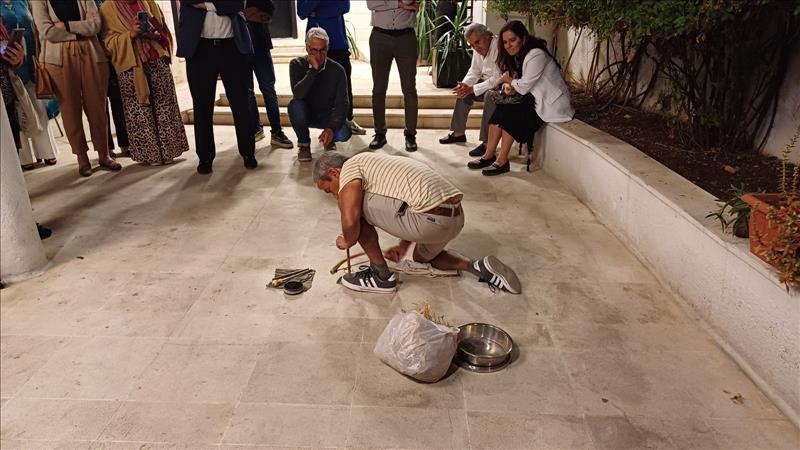
403
Sorry!!
Error! We're sorry, but the page you were looking for doesn't exist.
Kharaysin Site In Zarqa Dates Back To About 10,000 BC, Reveals Spanish Archaeologist
(MENAFN- Jordan News Agency)
Amman, Oct. 21 (Petra) -- The archaeological site of Kharaysin in Zarqa Governorate dates back to about 10,000 B.C. and represents early pastoralist and agricultural communities in Jordan, said Juan Ramon Muniz, a Spanish archaeologist, a member of the Spanish National Council for Scientific Research, and a lecturer at the University of Salamanca in Spain.
In a lecture titled "Kharaysin: A Settlement for Jordan's First Pastoralists and Farmers" at the Spanish Cultural Center in Amman on Sunday evening, in the presence of Spanish Ambassador to Jordan Miguel de Lucas, Muniz said that the pre-Pottery Stone Age site of Khreisan covers an area of about 30 hectares (approximately 300 dunums)."
In the lecture, attended by the Venezuelan ambassador to Jordan, Omar Vielma Osuna, Muniz explained that the site, which was discovered in 1984, is a large settlement on the foot of a hill linking the portico of Jabal al Mutawwaq and the right bank of the Zarqa River, and includes several areas, as the archaeological mission divided the place into several areas for the purposes of research and excavation, indicating that the lower areas have discovered traces dating back to 10 thousand years BC, while the traces at the top of the mountain revealed that they date back to about 6 thousand years.
He said that the excavations revealed many graves and relics belonging to the so-called "dolmen" or "rock tables," which are burial chambers, some examples of which contained rooms that were dug below ground level and were dedicated to burying the dead, as the dead were buried with their personal belongings.
Muniz pointed out that in 1989, the Spanish archaeological mission found houses dating back to the Stone Age pottery at the Kharaysin site, and among the most prominent artifacts discovered were the houses, as the population that shifted from nomadic living to settlement relied on collecting food and raising animals that lived with them during the Paleolithic and Mesolithic periods.
Amman, Oct. 21 (Petra) -- The archaeological site of Kharaysin in Zarqa Governorate dates back to about 10,000 B.C. and represents early pastoralist and agricultural communities in Jordan, said Juan Ramon Muniz, a Spanish archaeologist, a member of the Spanish National Council for Scientific Research, and a lecturer at the University of Salamanca in Spain.
In a lecture titled "Kharaysin: A Settlement for Jordan's First Pastoralists and Farmers" at the Spanish Cultural Center in Amman on Sunday evening, in the presence of Spanish Ambassador to Jordan Miguel de Lucas, Muniz said that the pre-Pottery Stone Age site of Khreisan covers an area of about 30 hectares (approximately 300 dunums)."
In the lecture, attended by the Venezuelan ambassador to Jordan, Omar Vielma Osuna, Muniz explained that the site, which was discovered in 1984, is a large settlement on the foot of a hill linking the portico of Jabal al Mutawwaq and the right bank of the Zarqa River, and includes several areas, as the archaeological mission divided the place into several areas for the purposes of research and excavation, indicating that the lower areas have discovered traces dating back to 10 thousand years BC, while the traces at the top of the mountain revealed that they date back to about 6 thousand years.
He said that the excavations revealed many graves and relics belonging to the so-called "dolmen" or "rock tables," which are burial chambers, some examples of which contained rooms that were dug below ground level and were dedicated to burying the dead, as the dead were buried with their personal belongings.
Muniz pointed out that in 1989, the Spanish archaeological mission found houses dating back to the Stone Age pottery at the Kharaysin site, and among the most prominent artifacts discovered were the houses, as the population that shifted from nomadic living to settlement relied on collecting food and raising animals that lived with them during the Paleolithic and Mesolithic periods.

Legal Disclaimer:
MENAFN provides the
information “as is” without warranty of any kind. We do not accept
any responsibility or liability for the accuracy, content, images,
videos, licenses, completeness, legality, or reliability of the information
contained in this article. If you have any complaints or copyright
issues related to this article, kindly contact the provider above.


















Comments
No comment